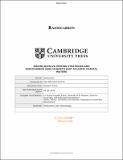Files in this item
Marine bivalve feeding strategies and radiocarbon ages in Northeast Atlantic coastal waters
Item metadata
| dc.contributor.author | Lo Giudice Cappelli, Elena | |
| dc.contributor.author | Austin, William Edward Newns | |
| dc.date.accessioned | 2020-01-01T00:37:21Z | |
| dc.date.available | 2020-01-01T00:37:21Z | |
| dc.date.issued | 2019-07-01 | |
| dc.identifier.citation | Lo Giudice Cappelli , E & Austin , W E N 2019 , ' Marine bivalve feeding strategies and radiocarbon ages in Northeast Atlantic coastal waters ' , Radiocarbon , vol. First View . https://doi.org/10.1017/RDC.2019.68 | en |
| dc.identifier.issn | 0033-8222 | |
| dc.identifier.other | PURE: 259378257 | |
| dc.identifier.other | PURE UUID: 46154e33-29ff-4f73-a16f-08da4f66a492 | |
| dc.identifier.other | Scopus: 85078928096 | |
| dc.identifier.other | WOS: 000510445400007 | |
| dc.identifier.uri | https://hdl.handle.net/10023/19213 | |
| dc.description | Authors acknowledge the support of NERC and an award to WA through the RAPID program (project NE/C000137/1). | en |
| dc.description.abstract | Marine mollusk shells have been extensively used to provide radiocarbon (14C)-based chronologies in paleoenvironmental and archaeological studies, however uncertainties in age measurements are introduced because secondary factors such as vital effects and diet may influence 14C incorporation into these shells. Deep burrowing and deposit feeding mollusks, in particular, may incorporate “old” carbon resulting in apparently older ages than their contemporary environment. In this study, we present paired 14C and stable isotope (δ13C and δ18O) measurements for nine species of known-age bivalves having different feeding strategies and collected in six localities around the NE Atlantic. We exclude potential “old” carbon contamination in these known-age mollusk shells, acquire a better understanding of local ecology and provide an improved context for the environmental interpretation of 14C ages. Our results indicate that, in the NE Atlantic, marine mollusk-derived 14C ages provide a reliable basis for environmental and archaeological investigation, independently of vital effects and differences in microhabitats, feeding strategies and sample location—all of which are apparent from stable isotopes. | |
| dc.format.extent | 19 | |
| dc.language.iso | eng | |
| dc.relation.ispartof | Radiocarbon | en |
| dc.rights | Copyright © 2019 by the Arizona Board of Regents on behalf of the University of Arizona . This work is made available online in accordance with the publisher’s policies. This is the author created, accepted version manuscript following peer review and may differ slightly from the final published version. The final published version of this work is available at https://doi.org/10.1017/RDC.2019.68 | en |
| dc.subject | Diet | en |
| dc.subject | Mollusks | en |
| dc.subject | Paleoecology | en |
| dc.subject | Radiocarbon | en |
| dc.subject | GC Oceanography | en |
| dc.subject | GE Environmental Sciences | en |
| dc.subject | QC Physics | en |
| dc.subject | NDAS | en |
| dc.subject.lcc | GC | en |
| dc.subject.lcc | GE | en |
| dc.subject.lcc | QC | en |
| dc.title | Marine bivalve feeding strategies and radiocarbon ages in Northeast Atlantic coastal waters | en |
| dc.type | Journal article | en |
| dc.contributor.sponsor | NERC | en |
| dc.description.version | Postprint | en |
| dc.contributor.institution | University of St Andrews. Coastal Resources Management Group | en |
| dc.contributor.institution | University of St Andrews. School of Geography & Sustainable Development | en |
| dc.contributor.institution | University of St Andrews. Marine Alliance for Science & Technology Scotland | en |
| dc.contributor.institution | University of St Andrews. Scottish Oceans Institute | en |
| dc.contributor.institution | University of St Andrews. St Andrews Sustainability Institute | en |
| dc.identifier.doi | https://doi.org/10.1017/RDC.2019.68 | |
| dc.description.status | Peer reviewed | en |
| dc.date.embargoedUntil | 2020-01-01 | |
| dc.identifier.grantnumber | NE/C000137/1 | en |
This item appears in the following Collection(s)
Items in the St Andrews Research Repository are protected by copyright, with all rights reserved, unless otherwise indicated.

